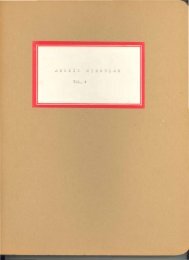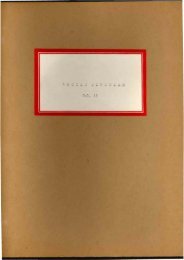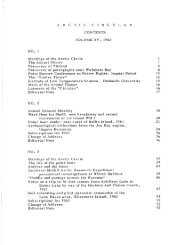Volume 24-25, 1976-7 - The Arctic Circle - Home
Volume 24-25, 1976-7 - The Arctic Circle - Home
Volume 24-25, 1976-7 - The Arctic Circle - Home
- No tags were found...
You also want an ePaper? Increase the reach of your titles
YUMPU automatically turns print PDFs into web optimized ePapers that Google loves.
4TVOL. )Cff No. 2TTIE ARCTIC CIRCTJIARBefore elephant ivory becare o:nnrcn on the Er:ropean nrarket in the lateItidd.Ie Ages, Greenlanders provided much of Europe 's ivory in the formof waln:s tusks . Leather, especially ropes rnade frcrn walms hides , isnentioned in nediaeval sources.After conversion to CfristianiQr, tkre l\trorse discovered that dried fish,especially codfish was a highly saleable itsn on the Er-rropean market andtlrey increased tlreir fishing beyond househrold needs. Thre birch barknet silker at L'Anse au>c }4eadows rnight be an indication of such ccnnercialfishing, although tlre rich cod gror:nds of Newfor:ndland are not nentioned inthe lbrse sagas.Traditionally, because of tJ-e northrern climate, p@r soils , and shortgror,ving seasons, the West lrlorse practised little or no agriculture.Ttreir primary staples were neat and dairy products and good pastr:res weretLre overriding consideration in the selection of areas for settlement.LrAnse aux lt4eado,vs with its vast expanses of heathr corrT)ares favor:rablyto Iceland and Greenland, and one r,qcnders if the Norse brought cattle orother dqnestic anjmals with thern. T\^D pig bones \^/ere for-nd in Hous€ A,but it is not kncxrn if ttrey are frun tlre l'trorse occalpation or later. IrIoportions of the buildings are obviously barns. Ttre lack of far:nal evidencecould be attributed to the hj-gh acidity of the bog and soil-s of the terraces.Ttre spindle whorl indicates that spirrning took place: but there are nosigns of sheep. Fibres other tiran rniool could have been sprrrl or vool couldhave been brought over in bales rather than on the baclcs of sheep.Iron was rnrcrked on tJle site and one could suspect that iron was one of ttremajor attractions . Conditions for iron production are favor.rrable: substantialbog iron deposits along thre brook, and plentiful fuel for sreltingand forging. Snelting sites are generally traceable through large stagheaps. As previously nentioned, iron slag has been for:nd at L'Anse auxIt@adorus, but only in snall qr:antities, a nnxirrn-un of 15 kg , of rnftich 10 kglrere collected. Thre ratio of iron produced to ttre qr:antity of slag, wasabout Lz4 or L:3, vihich rreans that at the nxrst, a total of 5 kg of ironwas prcduced at L'Anse au< irbadcnrs (that is, proviCed a-11 Lhe slag issnelting slag and not frcrn forging, a qluestion not yet resolved) . Thisis not a sufficient anrcunt of iron to have been tLre ec"'cncntic m ainstay oftlre settlenent. It is nrcre likely a one-tjrre operation to neet an jrmrediateneed.On ttre available evidence, our conclusion is that the Norse settlenent atLrAnse au< Itdeadows was relatively srnll and short-lived. It rnay not evenhave been intended as a pennanent settlenent but rathrer as a seasonalresource carp. This mnfornq. weII w-itfr the Vinland sagas. Late Archaiclndians nay have been on the site at the saIIE tine as the Norse, anrd,if sor rnay have been the Skraelings of the sagias" Whether L'Anse auxlbadq,vs is the long-sought Vinland, or nerely a previously tmrecordedNorse canp, the site is r:nigue in r]re ngu r,.orld.












